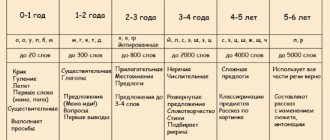Modern children from an early age are overloaded with graphic information. Most 3-4 year old children already know how to use smartphones and tablets, play mobile games, and watch cartoons. As a result, when it comes time to study, they have difficulty comprehending textual information. Unfortunately, poor reading technique is a problem familiar to many parents of schoolchildren today. Children read uncertainly and at a slow pace, take a long time to complete tasks, which negatively affects their overall performance both in elementary school and in middle and high school.
So why do you need speed reading?
Speed reading is a skill that allows you to quickly perceive textual information.
But we are talking specifically about the perception of the text, and not automatic swallowing. Phenomenal speed without reading comprehension will not only not help in your studies, but rather will do harm.
Teachers understand speed reading as a developed skill in processing educational material. This means that a student who masters this skill can quickly study and assimilate paragraphs of textbooks, scientific articles and other educational information. If a child reads slowly, he has little time left to analyze information and complete a task (for example, when writing a VPR). In order for a student to feel confident in tests and tests and to successfully master the program, he needs to master the skill of fast reading.
In addition, we can highlight several more advantages in a student mastering the technique of speed reading.
- Memory is trained.
A child can not only remember, but also retell large amounts of information. - Interest in learning increases
and self-confidence increases. - copes with homework
much , which frees up time for hobbies, interesting activities, and relaxation. - Visual attention and concentration
develops .
Advantages
The advantages of the speed reading technique include the following:
- with regular classes, it is possible to get rid of most of the mistakes typical of elementary school students (rearranging syllables in words, replacing letters, hesitations);
- high reading speed is directly related to high academic performance.
- Exercises help improve memory and promote the development of thinking.
This is why training should be done on a regular basis. However, you should not force your child to study or scold him if something doesn’t work out, otherwise there is a high risk that he will perceive the book in a negative light. Children of primary school age should actively use gaming technologies and visualize what they read. To do this, parents can select illustrations for the text and show them to their child. This will help him understand the meaning.
What prevents a child (and an adult) from reading quickly?
1. Narrow text perception space (field of view).
For most people, it is 4-5 cm. This is how much text a person sees when reading. To master the technique of speed reading, it is necessary to develop peripheral vision and expand this space to 7-8 cm.
2. Eye regression.
This is a very common reflex - a mechanical return movement of the eyes to the text that has already been read. After reading part of the text, a person automatically looks back and wastes time. It is impossible to prevent yourself from returning to a text you have already read through willpower; this will require training.
3. Articulation.
When a child is just learning to read, he reads out loud, pronounces words clearly and loudly. The child grows up, but the habit of internally pronouncing the text (and sometimes moving his lips while doing so) remains. In certain situations, this may be justified in the future - for example, when reading poems, when it is important to feel logical stress and pause. But for fast reading, articulation is not needed.
5. Undeveloped attention.
To understand new information, to instantly grasp the main and secondary ideas when reading fluently, you need to have increased attention and not be distracted by external factors.
Rules for organizing classes
When working on speed reading techniques, it is important to adhere to several rules that will make each lesson as productive as possible.
- You should strive to ensure that your child reads and does exercises regularly, preferably every day, and not to ensure that he reads a lot at one time.
- Don’t underestimate the importance of rest, so you should take short breaks during training so that your baby can rest and gain strength.
- It is imperative to praise the child for efforts, and especially for success, but reprimands must be avoided, since parental dissatisfaction will reduce both motivation and interest.
In the learning process, it is good to use an element of healthy competition, so you can sometimes give the child the opportunity to “beat” the parent and read faster than dad or mom. This will give him faith in his own strength and the desire to make further progress.
Learning to read quickly
Exciting exercises:
1. “Race”
This exercise allows you to increase your reading speed and promotes speech development. Choose a favorite poem with your child and offer to read it several times, each time increasing the pace as much as possible.
2. «Letter in a Bottle"
Tell your child the story that you came across a bottle with a letter caught from the sea. But some letters were washed away by water, and reading the message will not be so easy. The content of the letter can be anything you choose, but the letters should be “erased” depending on how well the child already reads.
3. "Head and tail"
There are two options for performing this exercise. In the first version, the adult reads the beginning of the word, and the child must find its ending (“tail”). To do this, you need to run your eyes through the text as quickly as possible and find the necessary word. The second option involves the adult reading the beginning of the sentence, and the child needs to find the end. This training perfectly develops the ability to “scan” text with your eyes, and also increases concentration (remember, we already said how important this is?)
4. "First and last"
Ask your child to read the text silently, but say the first and last letter of each word out loud. Then let him tell you what the text was about. The exercise teaches you to quickly switch attention and simultaneously perform several actions (reading, understanding, memorizing).
5. "Partisan"
The child reads the text aloud. But when an adult says the word “Partisan,” the child needs to put his finger to his lips (another option is to take a pencil between his teeth) and continue reading in silence. Having heard the phrase “The partisan escaped,” the student removes his finger or pencil from his lips and continues to read aloud again. This is a useful practice for eliminating the pronunciation of words while reading.
Don't try to do all the exercises at once. Alternate them, change them, combine them so that the child does not get bored with them. The main thing is to exercise little by little, but regularly.
“Speed reading”: simulators from the publishing house “Planet”
A great help for parents and teachers in teaching speed reading techniques to schoolchildren are simulators from the Planeta publishing house. At the time of preparation of the article (late 2019-early 2021), the publishing house has already released manuals for grades 3 and 4 and is preparing to release manuals for grades 1 and 2.
These manuals contain unusual task texts, work with which will help schoolchildren to significantly increase their reading speed. By completing them, the child will learn to read without articulation, see entire sentences, and concentrate on reading. For each text, there are several questions to test awareness and practical tasks to consolidate skills.
A child can work with simulators either independently or with the help of parents or teachers. The child is asked to note the time and start reading the text “to himself”. Then indicate in a special window how much time was spent. The next day or the day after, you can repeat the exercise and record the time again. Check if you managed to read the text faster than before. On the back of each page there is a “helper” text; you can refer to it in cases where it is difficult to read “unusual” at first.
The texts are very diverse, the tasks are unusual and exciting, they will not let the student get bored and will increase his interest in reading books in general. What makes them unusual? Here the student will encounter texts written “upside down”, “noisy” texts (with superimposed “cobwebs” or “lattices”), without spaces, using different fonts, deformed and many other “odd” texts.
For example, let's look at a task from a 4th grade simulator with “noisy” text
.
The text of the fairy tale is covered with a “cobweb”. Reading such text helps expand peripheral vision and prevent eye regression. The web lines are superimposed so that they run through the words. As a result, the child has no choice but to read whole phrases and sentences at once, see as many words as possible, and guess what these words are. Also, cobwebs make reading in general difficult, and looking back becomes uncomfortable.
Let's look at another example from this tutorial - text with the top of the lines closed. This exercise also expands your field of vision and prevents regression.
Another beautiful task - text using different fonts
. You can prepare this kind of exercise yourself by choosing any passage you like. To do this, you just need to type the text in different fonts in a regular text editor. And this is what happens! In this way we again successfully combat eye regression. A new font in every sentence (or even every word) automatically catches the reader's eye.
Let's look at another effective exercise for eliminating regression using an example from a simulator for grade 3. The child is asked to read the text, starting from the last word of each sentence, that is, not from left to right, but from right to left. Since physiologically we always read from left to right, when reading “reverse” the eyes will no longer return to the right, because we do not have such a reflex. Check it out for yourself!
The tasks in the simulators are arranged from simple to complex. Let's look at the most difficult exercise - text with a superimposed grid. It can be confusing even for an adult! But such a text will be very interesting for a child to read; it is an excellent motivation for reading in general, and not just within the framework of the simulator.
Important! Do not forget that the child must read all these texts “to himself,” not out loud or even in a whisper! Remember that any pronunciation significantly reduces your reading speed.
Age
Researchers note that early speed reading lessons are more harmful than beneficial, because a child who is just getting acquainted with the printed word should try to read thoughtfully, consciously, and understand what is being said, and not strive to do it as quickly as possible. After all, due to the fact that the baby read everything quickly, but did not understand practically anything, the very meaning of reading is lost. Therefore, experts believe that it is not worth working on speed reading with children 7 years old, whose brains are already ready to perceive tasks - it is better to postpone training.
At the same time, certain exercises aimed at developing attentiveness and the ability to concentrate will be useful at this age.
Comprehensive training to increase reading speed is best carried out at the age of 10-12 - this is exactly what many teachers believe.
There is no clear answer to the question at what age to start classes. If parents see that their child at 7-8 years old reads well, understands the meaning, and can answer questions about its content, then they can begin to engage in separate speed reading exercises with him in a playful way. But if a student does not understand what is required of him, classes can be postponed for a year. Most experts categorically do not recommend conducting such training with preschoolers, even if they can read, since they often do not understand the differences between letters and sounds.
Articulation suppression
Schoolchildren cannot read without pronouncing the words to themselves, moving their tongue. For speed reading techniques, this needs to be corrected and eliminated. To combat this you can use:
Musical accompaniment
The text is read to the music. After a few lessons, music with words is turned on. It is advisable to use classical compositions. You should not include fast rhythmic compositions.
"Bumblebee"
When reading, the child is disturbed by a monotonous sound, similar to the buzzing of an insect.
Rhythm
During classes, an adult rhythmically taps his finger on a table or other object. Gradually the rhythm speeds up.
Lock
The child should purse his lips tightly and read to himself as quickly as possible. For additional effect, you can cover your mouth with your palm.
Exercise 9. “Oh, once! Again!"
For this exercise we will need a stopwatch and a text to read.
Read for 1 minute. We pay attention to reading speed, but you can forget about expressiveness for now. Ready? Go!
The minute is up. Stop! Let's make a mark where we left off.
Let's rest a little and read the same text again. Go! In a minute we make a notch. Wow! Already more.
What will happen the third time? And the third time will be even better!
What does this give us? Increase reading speed. And the child's motivation. He will see for himself that he is capable of more.
List of exercises
And here he is! List of special reading exercises:
- "Half a watermelon"
- "Lost Letters"
- "Very sharp eye"
- "Sherlock"
- "Through the Looking Glass"
- "Mad Book"
- "The Birds Have Arrived"
- "Partisan"
- “Oh, once! Again!"
- "The Mystery of the Missing Proposal"
Exercise 7. “The birds have arrived”
Show your child the phrase “the birds have flown.” And ask to read it:
- calmly;
- joyfully;
- loud;
- quiet;
- sad;
- with irritation;
- with fear;
- mockingly;
- with anger.
What will this give us? Ability to read expressively. And convey feelings and emotions with your voice. Don't get hung up on this one phrase. You can read proverbs, sayings, and tongue twisters with different intonations.
Exercise 2. “Lost letters”
Another exercise to develop anticipation.
Letters and words sometimes get lost. But even without some letters and words we can read. Shall we try?
Write on paper, print or write with a marker on a special board the phrases that you see below.
Bookshelf.
New... T-shirt.
Big...spoon.
Red... cat.
Here's another phrase:
Bobik ate all the cutlets
He doesn’t share…….
And here are some more:
Ok-ok-ok - we will build…….
Yuk-yuk-yuk - ours is broken......
Task: read by guessing letters and words that are not there. For the next lessons, come up with your own phrases, use new phrases, catchphrases, and proverbs.
How to help a child's development?
By following some tips, you can achieve good results during your child’s play activities.
Spend any time you spend together usefully: discuss the weather, seasonal phenomena, a plant or tree you saw on the way to kindergarten
Introduce your baby to concepts such as color, shape, smell, etc. Keep in mind that it is difficult for children to maintain attention on one thing for a long time. Therefore, you should not get angry when he begins to be distracted by extraneous things. Exercising against your will will not bring success
Practice when the child is inclined to do so. Stick to activities that are appropriate for the baby’s age and that he likes: modeling, drawing, games, applications, etc. Knowing what tasks your baby can handle, give him slightly more complicated ones. A smooth transition from play to academic activities occurs a year before entering first grade, but not earlier. Classes must be regular. Criticism of a child’s actions and successes is unacceptable. Praise and encourage your little student for small but real achievements.
To expand the field of vision and memory
Exercises for children to develop reading speed also involve working on peripheral vision, since if the radius of peripheral vision is very small, then this becomes a serious obstacle to fast reading. Therefore, every day you need to perform special exercises that will help solve the problem. A similar exercise has already been described earlier - Schulte tables. But there are other options.
- Working with shapes. You should draw a sun with several rays on a piece of paper. At the end of each ray, place a geometric figure familiar to the child. The student’s task is to look at the sun and name the figures in order.
- Improving photo memory. The exercise is performed on a computer or using pre-prepared cards. The parent prints a few words (or lays out cards on the table where they are written down). The child’s task is to read them and remember them; he looks at the words for 10-15 seconds. Next, the adult asks a question: was there a certain word in this row? The child must remember and give the correct answer.
Reading speed has a direct connection with memory, so it is very important to include various exercises in your training aimed at improving visual memory.
Exercise 6. “Mad Book”
Tell your child that sometimes some ill-mannered books behave rather strangely. They suddenly take it and turn upside down.
The child reads aloud. After a while you clap your hands. The child's task is to turn the book upside down and continue reading from where he left off. At first, you can make marks with a pencil so as not to get too lost in the text. And so on several times. Two, three full turns of the book.
If your student is only in 1st grade, or maybe in 2nd grade, but reading is still very difficult, then you can read not a book with texts, but short simple words printed one after another on paper.
What will it give? Eye coordination and the ability to navigate through text will develop. A letter standard will be formed. And the processing of information by the brain will improve.







![Letter L and sound [l]](https://pleshakof.ru/wp-content/uploads/bukva-l-i-zvuk-l-330x140.jpg)
